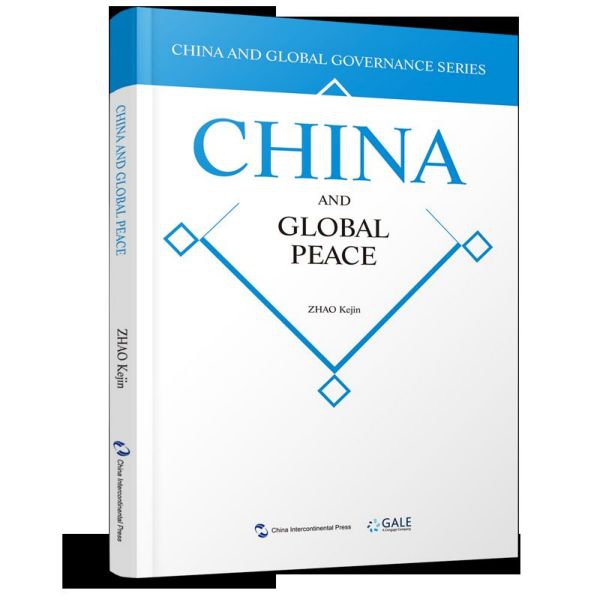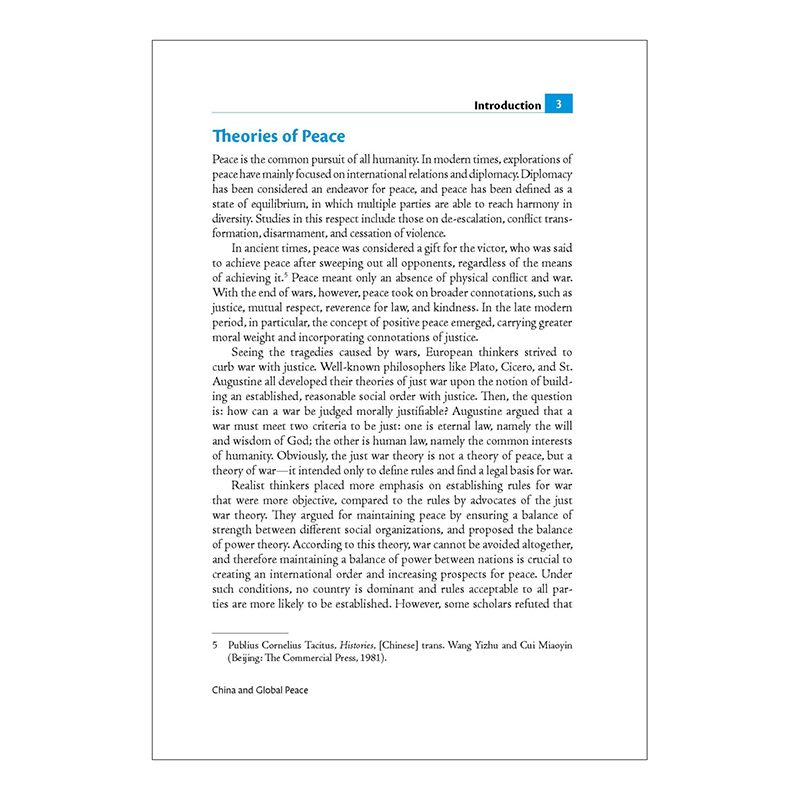
出版社: 五洲传播
原售价: 118.00
折扣价: 68.50
折扣购买: 全球和平的中国方案(英文版)/全球治理的中国方案
ISBN: 9787508542355

赵可金,男,1975年生,复旦大学法学(国际关系)博士,现为清华大学社会科学学院副院长、全球共同发展研究院副院长、国际关系学系主任,长聘教授,兼任教育部区域国别研究基地专家委员会委员、全国高校国际政治研究会常务理事、中国人民争取和平与裁军协会理事等学术职务,主要从事外交学理论、中国外交、中美关系等研究,出版各类著作18部,发表SSCI和CSSCI论文80多篇,先后荣获省部级奖励5项,入选教育部新世纪优秀人才,北京市“四个一批”优秀人才等支持计划。
In communication with others, it is inevitable for countries and peoples to encounter differences and conflicts. How to approach these problems is a test of a country’s wisdom. On this issue, traditional Chinese culture had, from the very beginning, established a virtue-over-force convention, favoring resolution through the use of morality, culture, proprieties, and law. Culture and rites were leveraged to influence people and ensure harmony: “If remote peoples are not submissive, culture and virtue are to be cultivated to attract them to be so.” In relations with remote peoples, China always adhered to a principle of moderation, adopting flexible policies and utilizing culture to resolve conflicts and ensure peace. China, known as a land of courtesy and propriety, has always cherished peace, revered morality, and avoided the use of force. Throughout history, even when faced with serious military challenges, it still put courtesy before force. “In governing a state, a sage will put culture and virtue before the use of force. Victory won with force will not win the hearts of people. Only when culture and virtue fail, should the use of force be adopted.” For thousands of years, the Chinese people always attached great importance to ancestral ethics and culture when understanding themselves and the world; culture was always a key factor in China’s consideration of its position in the world and its relations with other countries. The reason that China did not historically have clearly delineated borders is that it was used to approaching other countries with culture rather than force. In relations with neighboring countries, China always upheld wangdao and benevolence, using culture and virtue to influence people and carry out friendly interaction. Because they believed that wangdao and benevolence were the way to peace under heaven, Chinese rulers always stressed the need for a moral and ethical basis in foreign communication. This greatly influenced China’s philosophy of peace. At the same time, traditional Chinese culture was open to international communication, boosting China’s connections with the outside world. In internal and external relations, China emphasized the principle of putting oneself in others’ place and caring not only about oneself but also about others. Zhang Qian’s travel to the Western Regions in the Han Dynasty contributed to the opening of the ancient Silk Road; Xuanzang’s pilgrimage to the west for Buddhist scriptures and Jianzhen’s travel to Japan to propagate Buddhism reflected the integration of Confucianism, Taoism, and Buddhism; Zheng He’s voyages indicated the flourishing of the Maritime Silk Road; and the Ten Thousand Li Tea Road, from the Wuyi Mountain in southeastern China’s Fujian Province to Kyakhta in today’s Russia, and the Ancient Tea Horse Road running through Sichuan and Tibet in southwestern China showed the thriving tea trade. All these indicated that China had never completely closed its doors to the outside world (see Exhibit 1.1). Despite the many bans on interaction with foreign countries and maritime, land, and river trade in history, China’s cultural and people-to-people exchanges with other countries had never stopped. This is why China has always been able to reflect upon itself and remain vibrant. Chinese culture experienced three major instances of cultural blending. First, during the Han and Tang dynasties, Chinese culture met Buddhism, incorporating it and molding it into an important component of Chinese culture. Second, during the Song and Yuan dynasties, Chinese culture met Islam, and their integration produced the Hui culture, which also became an important element of Chinese civilization. Third, after the Ming and Qing dynasties, with the rise of the Western world, Chinese culture met Christianity and absorbed many Christian ideas. These cultural and people-to-people exchanges with foreign countries not only ensured the continuity of Chinese culture, but also expanded its influence worldwide. In modern times, Dr. Sun Yat-sen’s oncepts of peaceful reunification, harmony under heaven, philanthropism, peace, mutual assistance, and wangdao diplomacy were all a continuation and development of the traditional Chinese idea of using culture to influence people. For thousands of years, China has always stressed the use of culture to solve problems, opposing the use of one’s strength to bully the weak. A review of China’s millennia-old culture reveals an abundance of valuable thoughts on peace. The ideas of all under Heaven being one family, regarding peace as most precious, and using culture to influence people, in particular, are deeply embedded in the Chinese culture and run deep in the veins of the Chinese people. Despite their limitations due to the historical fetters of feudal autocracy, these ideas can certainly be innovated and developed to serve the present, help China produce more solutions for world peace, and contribute to building a better world. “全球治理的中国方案”丛书围绕“治理”“和平”“发展”三个最重要的主题,采取“3+7”的模式,共分为十分册。前三分册作为统领,围绕三大核心主题,综述中国完善全球治理体系的理念与实践,介绍中国参与全球治理的战略框架;其余七分册,按照当前全球治理的七大互动领域,包括金融安全、能源安全、气候治理、国际发展援助、人权保障、网络空间安全治理、国际反恐合作等,分别诠释全球治理具体领域的中国方案。


